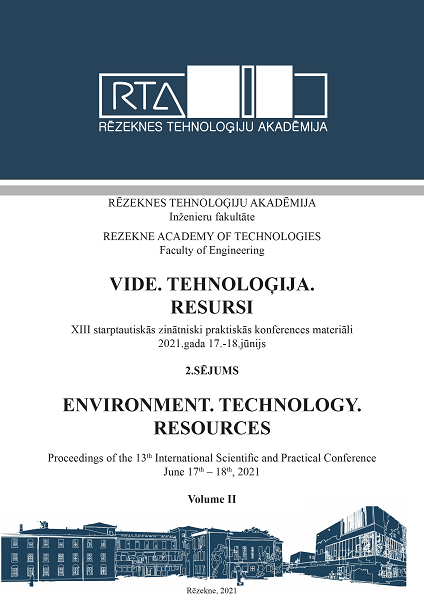SCIENTIFIC BASES FOR STOCK MARKET FIASCO FORECASTING TECHNOLOGY WITH USE OF INFORMATION SPACE ENTROPY
DOI:
https://doi.org/10.17770/etr2021vol2.6508Keywords:
Stock market, uncertainty, risk, forecasting, fiasco, collapse, Renyi entropy, information space, frequency, algorithm, technologyAbstract
The article contains a theoretical study and description of general algorithm for predicting a stock market fiasco caused by non-financial and other factors. Market fiasco is considered as non-periodical, sudden and random event which can arise due to the many latent reasons. Methods of technical and fundamental analysis are useless to solve this problem, therefore, the use of systems analysis methods is proposed. The author’s idea is the numerical calculation of search queries entropy as a part of global information space. Decrease in the Renyi’s entropy, associated with rapid grow search queries, containing key terms from the subject area, indicates the possible stock market fiasco in the near future. This article presents an algorithm for the dynamic calculation of Renyi’s entropy, allowing predict rare events which are not reflected in statistical data (or frequency of their realizations is too small). The method and algorithm can be realized in trade information systems and decision-making systems in economic sphere.
Downloads
References
N.N. Taleb, The Black Swan: The Impact of the Highly Improbable. Random House, New York, 2007, 400 p.
S.R. Baker, N. Bloom, S.J. Davis, S.J. Terry, “COVID-Induced Economic Uncertainty”. NBER Working Paper Series // National Bureau Of Economic Research, Cambridge, 2020, 16 p.
Mezhdunarodnaya praktika prognozirovaniya mirovyh cen na finansovyh rynkah (syr'e, akcii, kursyvalyut) / pod red. Ya.M. Mirkina. — M.: Magistr, 2014, 456 p. (In Russian)
R.H. Shumway, D.S. Stoffer, Time Series Analysis and Its Applications With R Examples. Fourth Edition, Springer, 2016, 558 p.
R.A. Ramos “Logistic Function As a Forecasting Model: It’s Application To Business And Economics”. International Journal of Engineering and Applied Science, March 2013, Vol. 2, N. 3, pp. 29 – 36.
B. Graham., D. Dodd, Security Analysis: Sixth Edition, Foreword by Warren Buffett, McGraw-Hill Irwin, 2008, 766 p.
C.S. Wasson, System Engineering Analysis, Design, and Development. Concepts, Principles, and Practices. John Wiley & Sons Inc.,Hoboken,New Jersey,Canada,2016, 846 p.
D.N. Zubarev, V.G. Morozov, Entropiya // Fizicheskaya enciklopediya: [v 5 t.] / Gl. red. A. M. Prohorov. — M.: Sovetskaya enciklopediya (t. 1-2); Bol'shaya Rossijskaya enciklopediya (t. 3-5), 1988-1999. (In Russian)
“Economic policy uncertainty”. [Online]. Available: http://www.policyuncertainty.com/ [Accessed: April 05, 2020];
“Global EPU Index through May 2017”. [Online]. Available: https://policyuncertainty.com/media/Global_Annotated_Series.pdf – [Accessed: April 05, 2020];
Ch. Syueczyun', Indeks neopredelennosti ekonomicheskoj politiki I volatil'nost' fondovogo rynka Kitaya primenitel'no k Rossii / CH. Syueczyun', M. Tyan', SH. YAn' // Innovacii i investicii. – 2019. – №9. – pp. 99-104; (In Russian)
W. Zhang, S. Skiena, Financial Analysis Using News Data. Stony Brook University, Stony Brook, NY, USA, 2008, 71 p.
S.J. Grisafi, Market Dynamics: The Mechanics of Financial Engineering. CreateSpace Independent Publishing Platform, 2013, 218 p.
C. Curmea, T. Preisb, H.E. Stanleya, H.S. Moat, “Quantifying the semantics of search behavior before stock market moves”, PNAS, August 12, 2014, vol. 111, No. 32, pp. 11600–11605.
A.V. Semyonova, M.V. Korsunskaya, Kontent-analiz SMI: problem I opyt primeneniya / Pod red. V. A. Mansurova. — M.: Institut sociologii RAN, 2010, 324 p. (In Russian)
“Eksperiment: Ispol'zovanie Google Trends dlya prognozirovaniya obvalov fondovogo rynka” in Blog kompanii ITI Capital. [Online]. Available: https://habr.com/ru/company/iticapital/blog/279021/ [Accessed February 07, 2020, 18.39 p.m.] (In Russian)
M. Gladuell, Perelomnyj moment. Kak neznachitel'nye izmeneniya privodyat k global'nym peremenam. Izdatel'stvo: Al'pinaPablisher, 2015, 374 p. (In Russian)
P. Glensdorf, I. Prigozhin, Termodinamicheskaya teoriya struktury, ustojchivosti i fluktuacij. M., 1973, 280 p. (In Russian)
A. Renyi, On Measures of Entropy and Information / A. Renyi // Proc. Fourth Berkeley Symposium - V.1 - Berkeley. Calif.: University of California Press, 1961, pp. 547-561.
O.L. Korolev, M.Yu. Kussy, A.V. Sigal, Primenenie entropii pri modelirovanii processov prinyatiya reshenij v ekonomike. Pod red. A.V. Sigala. Simferopol': Izdatel'stvo «ODZHAK"», 2013, 148 p. (In Russian)
“Chetvertaya promyshlennaya revolyuciya: Celevye orientiry razvitiya promyshlennyh tekhnologij i innovacij” in Informacionnyj dokument, Vsemirnyj ekonomicheskij forum, 2019, 49 p. (In Russian)
E. Foer, “Metafora katastrofy: kak upravlyat' riskami pri pomoshchi shvejcarskogo syra”. Theory & Practice, 2013. [Online]. Available: https://theoryandpractice.ru/posts/7427-metafora-katastrofy-kak-upravlyat-riskami-pri-pomoshchi-shveytsarskogo-syra [Accessed: May 05, 2020, 23.37 p.m.] (In Russian)


